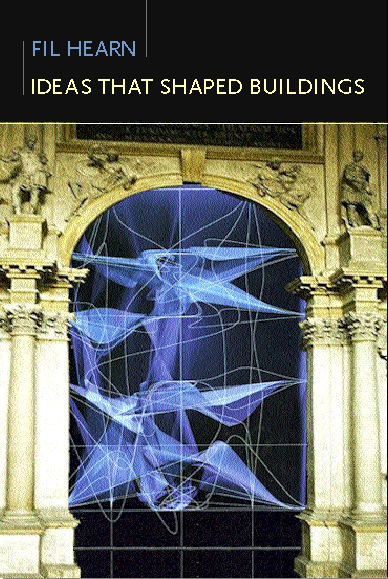

Ideas That Shaped Buildings, MIT Press, (Cambridge, Mass., 2003)
Covering the period from ancient Rome to the present, this book is the first to attempt to identify and codify the ideas (in influential treatises) on the theory of architecture that have impinged upon the design of buildings in Western civilization. After a profile history of the development of this tradition of architectural theory, it treats the evolution of the most important themes in theoretical lore.
Universally applicable to all theories of architecture are attributions of the importance in human society of architecture and the architect. Regarding the latter, these involve the scope of his professional activity and of his education, as well as appropriate professional standards. Along the same line and crucial to the development of architectural theory is the advancement of conceptual standards for judging the quality of a building and also of justifications that can place theoretical requirements beyond the reach of criticism. Equally universal is the appeal to older architecture as the example and justification for particular theoretical concepts.
While tracing certain ideas for as long as they remained vital to the theory of architecture, it became apparent that one set of themes was current from ancient Rome until about 1800 and another from 1800 to the present. In addition, there was also an important overlay of ideas that challenged this latter set, beginning about 1965 and continuing to the end of the century.
Theory before 1800 was addressed to the classical tradition of antiquity and the formulation of architectural designs in terms of a succession of ideal types employed as pre-existing images. Conceived from the outside in, these designs were formulated in terms of conventions set down for the classical columnar orders. Representing the means for achieving a universal and timeless beauty, these conventions were regarded as authoritative guides and were eventually held to be divinely inspired. There was, from an early time, a parallel set of conventions for breaking the rules and for achieving a more complex, subtle and sophisticated beauty. In both cases they were governed by extensive rules of proportion.
Theory after 1800 was addressed to the Gothic tradition of the Middle Ages and the rational formulation of architectural designs in terms of guiding principles. It espoused a design method that proceeds from the inside out, in a logical progression from plan to structure to exterior design to décor. Under this rubric, the plan, subject to no preconceived format, is to be rationally generated from a program of functional requirements. The structure is to be developed as the means for enclosing the spaces of the plan in a forthright manner that would clearly proclaim the way it is composed. The exterior elevations are to be developed as an extension of the plan and structure, without the imposition of preemptory design requirements, such as bilateral symmetry. It is assumed that a rational design is probably also beautiful and that a beautiful design necessarily begins by being rational. Decoration is to be a natural outgrowth of functional elements of the design and not added just for effect. Later generations adjusted these principles with varying degrees of emphasis, but essentially left them standing. Theory based on principles also came to be attached to the new activity of restoration and to the new expansion of architectural practice through the design of cities.
Theory since 1965 has challenged the claims of rational theory on the grounds that its aspiration to be both universally applicable and ahistorical makes it culturally meaningless. It advances two new principles—namely, that architectural design should be responsive to its context and that its functional requirements need not be resolved in a simple comprehensive solution. By extension of these new concerns, rationality of design is rejected in favor of various kinds of design complexity. The advent of the computer, which can facilitate both the composition and accurate representation of such formulations, has encouraged supra-rational design because it can produce not only accurate measurements for these complexities but even project them onto the process of cutting materials to measure. These uses, however, represent only some of the early apprehensions of the significance of the computer for the development of architecture and it is likely that future innovation in the theory of architecture will be addressed to different issues.
These challenges to the modern theory of principles have not made it obsolete. Indeed, neither modern nor post-modern principles have made the classical theory of conventions totally obsolete. Any one of the three traditions can still be a useful inspiration and guide to architectural design and all of them can be practiced using the computer.
